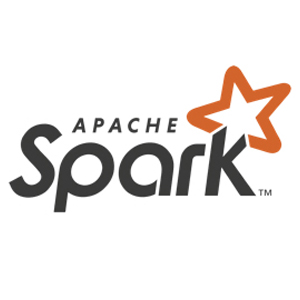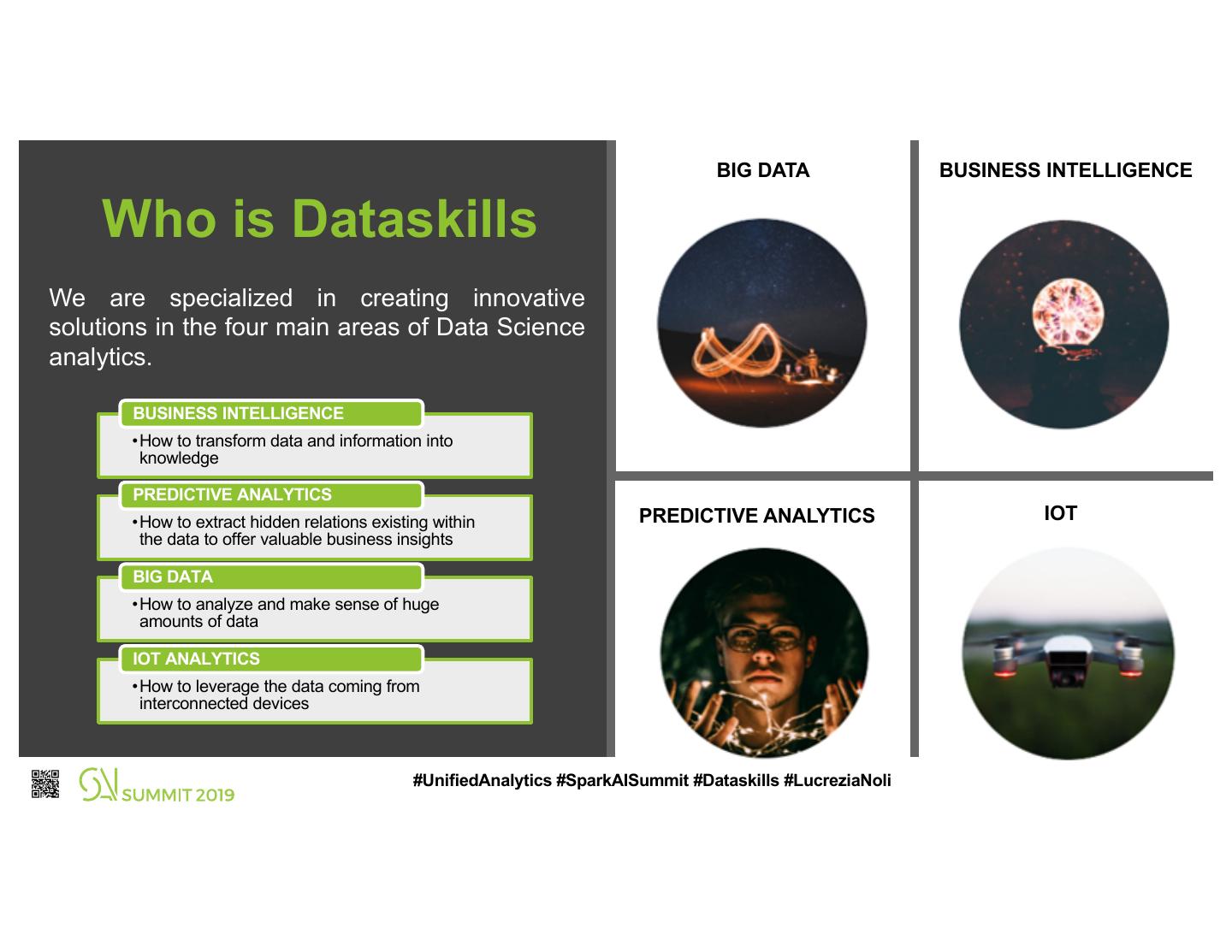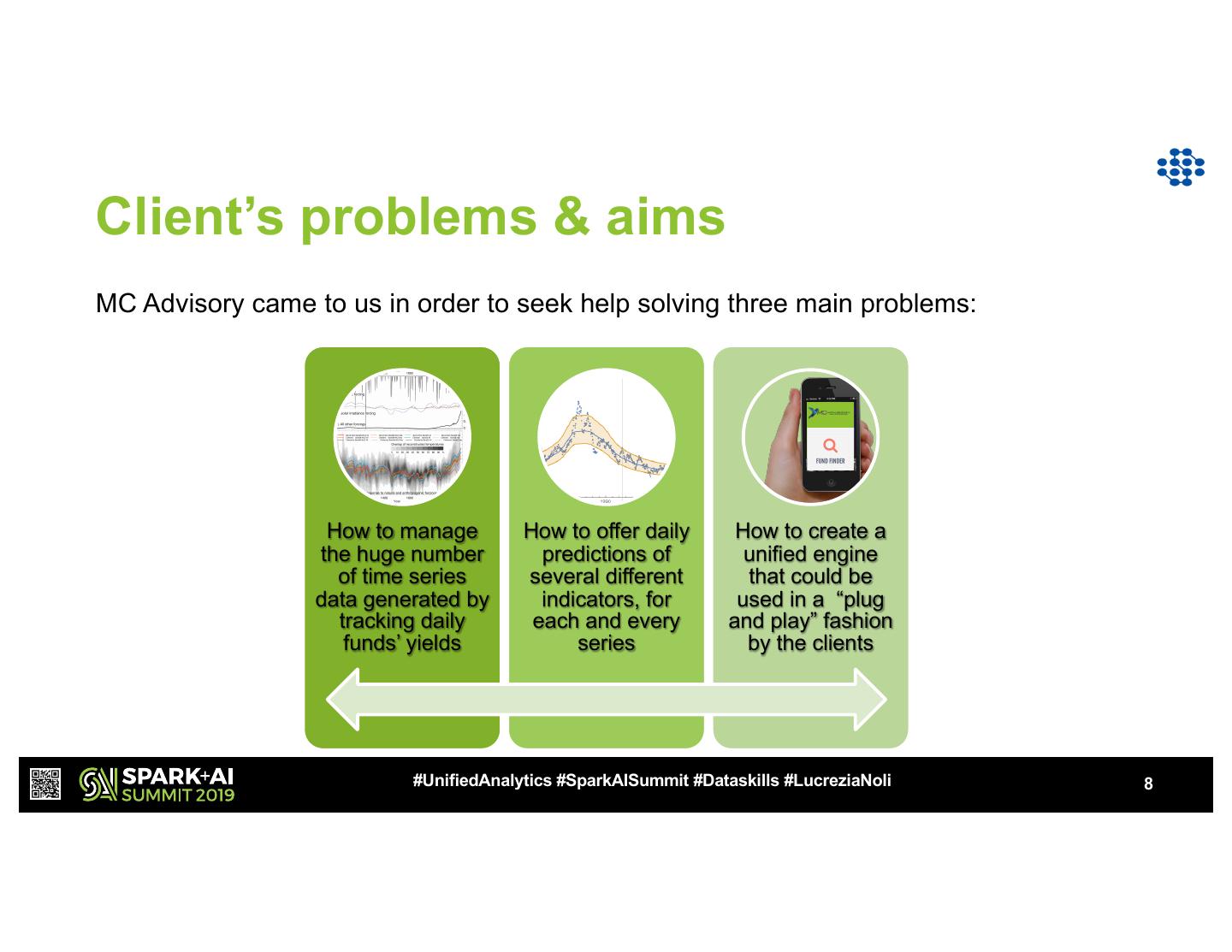- 快召唤伙伴们来围观吧
- 微博 QQ QQ空间 贴吧
- 文档嵌入链接
- 复制
- 微信扫一扫分享
- 已成功复制到剪贴板
Working with 1 Million Time Series a Day: How to Scale Up a Predictive Analytics
展开查看详情
1 .WIFI SSID:SparkAISummit | Password: UnifiedAnalytics
2 .WORKING WITH 1M TIME SERIES A DAY: how to scale up a predictive analytics model switching from sequential to parallel computing Lucrezia Noli, Dataskills #UnifiedAnalytics #SparkAISummit #Dataskills #LucreziaNoli
3 . LUCREZIA NOLI § Previous roles § Business Development Manager at Metail, London § Education § Bocconi University § Bachelor in Finance § Master in Economics of Innovation & Technology § Master Thesis: «Machine Learning Techniques to Investigate the ALS Disease» § Won second prize of PRISLA competition for research on ALS disease § Current roles § Big Data Scientist and Community Evangelist at Dataskills § Fellow at SEDIN, Department of Informatics, Bocconi University § Lecturer for Overnet Education #UnifiedAnalytics #SparkAISummit #Dataskills #LucreziaNoli
4 .I’m here to talk about A plug & play engine for efficiently analyzing time series data A tool to create optimal portfolios of traded funds, given specific clients’ characteristics An innovative way to use Spark to make this all happen #UnifiedAnalytics #SparkAISummit #Dataskills #LucreziaNoli 4
5 . BIG DATA BUSINESS INTELLIGENCE Who is Dataskills We are specialized in creating innovative solutions in the four main areas of Data Science analytics. BUSINESS INTELLIGENCE •How to transform data and information into knowledge PREDICTIVE ANALYTICS •How to extract hidden relations existing within PREDICTIVE ANALYTICS IOT the data to offer valuable business insights BIG DATA •How to analyze and make sense of huge amounts of data IOT ANALYTICS •How to leverage the data coming from interconnected devices #UnifiedAnalytics #SparkAISummit #Dataskills #LucreziaNoli 5
6 .Who is Dataskills 25 40 Years of Active experience clients 3 3 DataScience Lecturers at books Bocconi published University #UnifiedAnalytics #SparkAISummit #Dataskills #LucreziaNoli 6
7 .MC Advisory Financial consulting firm, with a main differenciating asset: Robo4Advisor Ø It’s a tool ideated for constructing an optimal funds’ portfolio. It helps professional financial advisors to better serve their clients Ø It has two main traits: Funds’ Selection Filter & Optimal Portfolio Builder Fund Selection: § Optimized selection based on markets § Innovative engine based on client’s requirements: stability, yield, etc. Optimal Portfolio Builder: § Based on proprietary solution ideated by Dataskills, which predicts funds’ performances by monitoring various performance metrics. The engine works as a plug-and-play tool, but is optimized for each and every single fund, as if each of them had a dedicated model. #UnifiedAnalytics #SparkAISummit #Dataskills #LucreziaNoli 7
8 .Client’s problems & aims MC Advisory came to us in order to seek help solving three main problems: How to manage How to offer daily How to create a the huge number predictions of unified engine of time series several different that could be data generated by indicators, for used in a “plug tracking daily each and every and play” fashion funds’ yields series by the clients #UnifiedAnalytics #SparkAISummit #Dataskills #LucreziaNoli 8
9 .The architecture Collection of funds Prediction of funds’ yields yield increment to create Time-series predictive most efficient portfolios engine composed of different models DAILY REASSESMENT OF MODEL PERFORMANCE #UnifiedAnalytics #SparkAISummit #Dataskills #LucreziaNoli 9
10 .The architecture Performance DATA: •Incremental change of funds daily return 25,000 time-series data on funds’ yields Value at Risk estimation •Maximum expected loss 5 TARGETS: MODELS: Expected volatility • Performance § Deep Neural • Expected volatility Network SCORING •Standard deviation of fund’s yield • VAR § Random Forest METHOD: • Drawdown § Gradient Drawdown Boosting PREDICTIONS: • Efficiency indicator Machine Each day a § •Percentage XG proprietary algorithm Boosting peak-to-through decline Stock-by-stock § Recurrent Neural assesses which predictions permit Efficiency indicator Network model is the best- the client to § LSTM performing for each create optimal •Based on proprietary MC Advisory formula series funds portfolios #UnifiedAnalytics #SparkAISummit #Dataskills #LucreziaNoli 10
11 .Treating time series Two important aspects of time series analysis: Ø Predictive variables are the lags of the variable of interest Ø When splitting between training and test sets, we have to take time into account Time Return t-4 v4 t-4 t-3 t-2 t-1 t t-3 v3 t-2 v2 v4 v3 v2 v1 v t-1 v1 0 t v 0 t-x 90 T Training setTraining set window Test is a 90 days Testsetset is a 15 days window #UnifiedAnalytics #SparkAISummit #Dataskills #LucreziaNoli 11
12 . Step 1: developing a sequential model Comparing every model every day, as was Build our inital aim, is too time-consuming if sequential computed sequentially Python models Pick a single It is not optimal to confine to a single best model to algorithm to predict so many differently- make daily behaving funds predictions To offer predictions daily we would need to Use alternative pick a single best-performing model, and models only in only train other models if the performance some cases of the best one is not satisfactory enought. This is still very time-consuming! #UnifiedAnalytics #SparkAISummit #Dataskills #LucreziaNoli 12
13 .Step 2: hand-made parallelization 1 A first possible option was to manually parallelize calculation processes with python libraries, such as multiprocessing lib We faced two main problems: 2 • Number of parallelized threads would still be confined to number of cores • Have to distribute across multiple machines \ We finally opted for building the solution with Azure Databricks Spark : 3 • The cloud offers scalability on-demand, • Quicker & easier than manually creating spark clusters, and very user-friendly • efficient for massive processing in both data preparation & modelling phases #UnifiedAnalytics #SparkAISummit #Dataskills #LucreziaNoli 13
14 .Step 3: leveraging Spark capabilities How we use DATA PREPARATION Spark MODEL IMPLEMENTATION o Spark SQL is used for data o Spark engine is used fro preparation & feature engineering distribution, but we don’t use ML whenever possible libraries o Not possible when we need o Our need here is different from data transformations which are not common cases, because rather natively present in Spark (eg. FFT) than distributing a single model, we have several different models o Moreover, since all models have proprietary tweeks, we need to be able to implement our custom functions #UnifiedAnalytics #SparkAISummit #Dataskills #LucreziaNoli 14
15 .Step 3a: hand-made «RDD to pandas» Main problem Both for data preparation & modelling, some functions are integrated in Spark, but some others are not. We will need to distribute these functions «by-hand» to the Spark context. We don’t want to give up parallelization & distribution when applying our custom functions So we manually implemented a way to be able to use our custom functions, without giving up Spark’s computational efficiency #UnifiedAnalytics #SparkAISummit #Dataskills #LucreziaNoli 15
16 . Step 3a: hand-made «RDD to pandas» Repartition Spark Dataframe by Series_id 1 THIS IS THE CORE Don’t use to_pandas function. This will SOLUTION WHICH compute calculations in the driver node, 2 thus giving up Spark’s parallelization RDD to Pandas MAKES IT POSSIBLE TO Pandas to RDD APPLY CUSTOM Instead, go down one level to RDD, so that with Map Partition we can apply custom 3 FUNCTIONS TO OUR function to single partitions DATA IN A MASSIVE WAY Data is turned into pandas DF, but is still processed in worker nodes. 4 #UnifiedAnalytics #SparkAISummit #Dataskills #LucreziaNoli 16
17 .Hand-made solution to use custom functions Apply Apply Pandas to Spark DF RDD to custom DF to RDD custom Spark repartitioning pandas functions to prepare data algorithms Dataframe This logic is used for both data-preparation, when functions are not available in Spark SQL, and modelling, since we haven’t used Spark ML functions. #UnifiedAnalytics #SparkAISummit #Dataskills #LucreziaNoli 17
18 .Pandas UDFs Ø Introduced in Spark 2.3 and further developed in Spark 2.4 Ø Vectorized UDFs are a way to work on pandas dataframes without giving up Spark’s ability to distribute calculations Ø There are different types of pandas UDFs, we use the «grouped map» implementation, which uses the split- apply- combine logic Ø The functioning is the same as the solution we had implemented manually, but being natively included into Spark it works more efficiently DATA PREPARATION MODELLING § Because we need some functions which § Because we implement proprietary don’t exist natively in spark models § Because we need to parallelize several different models on small series, rather than a single model on huge series #UnifiedAnalytics #SparkAISummit #Dataskills #LucreziaNoli 18
19 .Pandas UDFs for data preparation This is an example of the structure of the code, simply used to convey the main concepts behind the use of Pandas UDFs Ø DEFINE OUTPUT SCHEMA Ø GROUP BY THE SERIES_ID Ø GROUP_BY HERE IS ANOTHER UNUSUAL TWEAK. NOT NECESSARY, BUT USED SO THAT WE CAN CREATE SLIDING WINDOWS #UnifiedAnalytics #SparkAISummit #Dataskills #LucreziaNoli 19
20 .Pandas UDFs for modelling This is an example of the structure of the code, simply used to convey the main concepts behind the use of Pandas UDFs Ø @pandas_udf is a decorator that supercharges my function with additional functionalities, like transforming spark DF to pandas DF (and vice-versa) Ø Implement your ad-hoc model here #UnifiedAnalytics #SparkAISummit #Dataskills #LucreziaNoli 20
21 .Performance comparison 2 computationally expensive tasks Data Modelling preparation 4 sec per 15 sec per series model SEQUENTIAL SPARK-RDD PANDAS UDFs SEQUENTIAL SPARK-RDD PANDAS UDFs 4 secs 4 secs 10 worker nodes 15 secs 15 secs 10 worker nodes x 5 functions x 5 functions 32 cores x 5 functions x 5 functions 32 cores x 25K series x 25K series x 25K series x 25K series 1h 28 h 13 min 8.7 min 44 min 520 h 2 h 26 min 1 h 36 min 320x 1.5x 320x 1.5x #UnifiedAnalytics #SparkAISummit #Dataskills #LucreziaNoli 21
22 .Steps forward This is an ongoing project, for which we envision several future developments: GROWING COMPLEXITYà more series, more target variables, more models ANALYSIS OF DIFFERENTIALS à not just analyze a fund’s return by itself, but comparing it to the average return of all other funds in the same market TIME-SERIES CLUSTERINGà helpful for both data preparation (fill missing values) and modelling (additional information) USE OF SPARKà a further improvement that will likely add efficiency is the identification of steps requiring same processing time, so as to organize them in a way that doesn’t block worker nodes #UnifiedAnalytics #SparkAISummit #Dataskills #LucreziaNoli 22
23 .DON’T FORGET TO RATE AND REVIEW THE SESSIONS SEARCH SPARK + AI SUMMIT




























